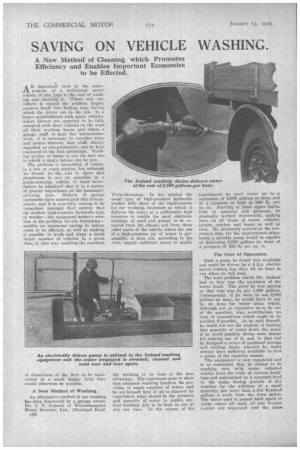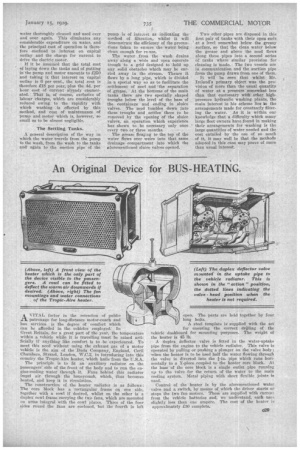SAVING ON VEHICLE WASHING.
Page 12

Page 13

If you've noticed an error in this article please click here to report it so we can fix it.
A New Method of Cleaning which Promotes Efficiency and Enables Important Economies to be Effected.
A N important item in the maintenance of a well-found motor vehicle of any type is the cost of waAing and cleaning it. Where only one vehicle is owned the problem largely resolves itself into finding time during which the driver can do the job.. In a huger establishment with many vehicles. where drivers are expected to be fully occupied with their vehicles on the road all their working hours and where a garage staff. is-kept for maintenance work, .it is necessary to consider ways and means whereby that staff, always regarded as non-productive, can be kept. employed to the best advantage. Washing lorries or buses-is not the best use to which a man's labour can -be put. The problem is intensified, of course. in a hos or coach station, for, although we should be the last to agree that cleanliness is not an essential in a goods-carrying vehicle, it must never. theless be admitted' that it is a matter of greater importance on the passengercarrying type. Makers of garage equipment-have appreciated this circumstance, and it is generally coming to be recognized amongst fleet owners that the Modern high-pressare hydraulic type 'of washer--the equipment maker's solution of the problem we are discussing-enables an enormous saving in labour costs to be effected, as well as making it possible to wash and clean a much larger number of vehicles in a given time, in that way enabling the standard
of cleanliness of the fleet to be maintained at a much higher level than would otherwise be possible.
A New Method of Washing.
An alternative method of car washing has been discovered by a garage owner, Mr. J. T. Ireland, of Wolverhampton Motor Services, Ltd., Cleveland Road,
c28 Wolverhampton. In his opinion the usual type of high-pressure hydraulic washer falls short of the• requirements for car washing, inasmuch as whilSt it delivers the water at a sufficiently high pressure to enable the most obstinate coatings of mud and grease to be removed from the chassis and from those other parts of the vehicle where the use of a high-pressure jet of water is permissible, it does not, according to his view, supply sufficient water to enable the washing to be done to the best advantage. His experience goes to show that adequate washing involves the provision of ample supplies of water, and he set himself first of all to discover by experiment what should be the pressure and quantity of water to enable, say, four washing jets to be kept in use at any one time. In the course of his
experiments he used water up to u maximum of 8,000 gallons an hour And at a pressure as high as 800 lb. per sq. in. Starting at these upper limits, both of quantity arid pressure, he gradually worked downwards, making tests on all kinds of motor vehicles, lorries, coaches and buses as well as cars. He ultimately arrived at the conclusion that, for the requirements stipulated, a suitable pump would be capable of delivering 2,000 gallons an hour at a pressure of 120 lb. per sq. in.
The Cost Of Operation.
Such a pump he found was available and could be driven by a 4 h.p. electric motor costing less than 4d. an hour to tun when on full load.
The next problem which Mr. Ireland had to face was the provision of the water itself. The price he was paying at that time was is. per 1,000 gallons. Consequently, if he were to use 2,000 gallons an hour, he would have to pay 2s. an hour for water alone which, although not so expensive as to be out of the question, was, nevertheless, an item of expenditure which ought to be avoided if possible. As he said himself, he could not see the wisdom of turning that quantity of water down the drain' if he could possibly devise some means for making use of it. and to that end he designed a series of combined storage and settling tanks wherein he could always have sufficient available to feed a pump of the capacity named.
The equipment is now completed and is so successful that he claims to be washing cars with water collected mainly from the roofs of various buildings and maintained at a constant level in the tanks during periods of dry weather by the addition of a small quantity, not more than a few hundred gallons a week, from the town mains. The water used is passed back again to tanks where all mud, oil and foreign matter are separated and the same
water thoroughly cleaned and used over and over again. This eliminates any considerable expenditure on water, and the principal cost of operation is therefore confined to interest on capital outlay and the charge for current to drive the electric motor.
If it be assumed that the total cost of laying down the tanks and of putting in the pump and motor amounts to £250 and taking it that interest on capital outlay is 13 per cent., the total cost is therefore £18 per year, plus the 4d per hour cost of current already enumerated. That is, of course-, exclusive of labour charges, which are cOnsiderably reduced owing. to the rapidity with which washing is effected by this method, and cost of maintenance of pinup and motor which is, however, so small as to be almost negligible.
The Settling Tanks.
A general description of the way in which the water travels from the pump to the wash, from the wash to the tanks and again to the suction pipe of the pump is of interest as indicating the method of filtration, whilst it will demonstrate the efficiency of the precautions taken to ensure the water being clean enough for re-use.
The water . from the wash drains away along a wide and open concrete trough to a grid designed to hold im any solid obstacles which may be carried away in the stream, Thence it flows by a long pipe, which is divided in a special way se as to facilitate the settlement of mu4 and ':the separation of _grease. At the bottoms of the main tanks there are two specially shaped troughs below the level of the base of the containers and ending in sluice valves. The mud tumbles down into these troughs and settles there to be removed by the opening of the sluice valves, an operation which experience has shown to be necessary only once every two or three months.
The grease floaling to the top of the water flews over weirs into that same drainage compartment into which the aforementioned sluice valves opened. Two ,other pipes are disposed in this first pair of tanks with their open ends at a level somewhat below the greasy surface, so that the clean water below the grease and above the mud flows along these pipes into a second series Of tanks where similar provision for cleaning is made. The two vessels are in communication and the suction pipe from the pump draws from one of them.
lt will be seen that whilst Mr. Ireland's primary object was the provision of more than the usual quantity of water at a pressure somewhat less than that customary with .other highpressure hydraulic washing plants, the main interest in his scheme lies im the arrangements made for constantly filtering the water. As it is within our knowledge that .-a difficulty which many large fleet owners have found in making their arrangements for washing is the large quantities of water needed and the cost entailed by the use of. so much of it, it may well he that the methods adopted in this case may prove of more than usual interest.
































